Each chakra in the human body, when activated with the help of Kundalini, results in different attainments. Chakra`s are seven Lotuses, situated inside the vertebral column.
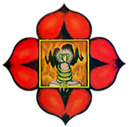 1. Muladhar Chakra:Situated at the basal region of the vertebral column and the symbol of the earth element, in meditation, this Chakra is visualized as a red lotus possessing four petals. Here lies the resting place of kundalini shakti or the three and a half coiled snake. Results of activation of this chakra:
1. Muladhar Chakra:Situated at the basal region of the vertebral column and the symbol of the earth element, in meditation, this Chakra is visualized as a red lotus possessing four petals. Here lies the resting place of kundalini shakti or the three and a half coiled snake. Results of activation of this chakra:
• Riddance from tensions
•Attainment of true happiness, beauty, perfect health, physical strength and a magnetic persona
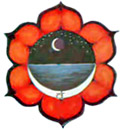 2. Swadhishtthan Chakra: Located in the vertebral column just opposite to the penial region, and the symbol of the water element, this chakra is visualized as a vermilion colored lotus having six petals. Results of activation:
2. Swadhishtthan Chakra: Located in the vertebral column just opposite to the penial region, and the symbol of the water element, this chakra is visualized as a vermilion colored lotus having six petals. Results of activation:
•Freedom from stomach ailment
•Increase in sex power
•Cure of sexual debility
•Increase in courage and fearlessness and magnetism
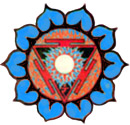 3. Manipur Chakra:This ten petalled blue-colored lotus, representing the fire element, is situated just opposite to the naval region. Results of activation:
3. Manipur Chakra:This ten petalled blue-colored lotus, representing the fire element, is situated just opposite to the naval region. Results of activation:
•Perfect digestion
•Riddance from ailments like kidney stones, diabetes, liver problems etc
4. Anahat Chakra:
Located just opposite the cardiac region, this red colored lotus possesses twelve petals and it represents the Air element. Results of activation:
•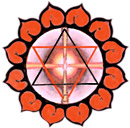 Peace of mind
Peace of mind
•Boundless divine joy
•Total freedom from tensions
•Power to look into future
•Power of hypnosis
•Entering into Samadhi (divine trance)
•Riddance from problems related to heart
•Increase in soft emotions like love, affection and kindness
5. Vishuddha Chakra: Inside the vertebral column this smoky colored Chakra, possessing sixteen petals, is located opposite the throat region. It represents the air 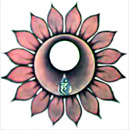 element. Results of activation:
element. Results of activation:
•Riddance from all ailments related to throat, thyroid etc.,
•Increase in knowledge
•Gain of power of eloquence
•Deeper Samadhi
•Perfection in the art of Hypnotism
•Gain of power to die when one wills
•Total material success like comforts, wealth, fame etc.
6. Aagya chakra:This white lotus, having only two petals, is located just opposite the mid-spot of the eyebrows. It is also called the Third Eye.Results of activation:

It brings wondrous powers like clairvoyance, telepathy, power of giving curses or blessings, instant fulfillment of anything one wishes, and gain of knowledge related to all subjects and sciences, power to control thoughts of others and interfere even in nature.
7. Sahastrar Chakra: Beyond these six Chakras at the upper termination of the 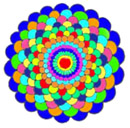 spinal cord, is the thousand petalled lotus; the abode of the Supreme Being, Lord Shiva. When the Kundalini Shakti unites itself with this Supreme Being, the aspirant gets engrossed in deep meditation during which he or she perceives infinite bliss.Results of activation:
spinal cord, is the thousand petalled lotus; the abode of the Supreme Being, Lord Shiva. When the Kundalini Shakti unites itself with this Supreme Being, the aspirant gets engrossed in deep meditation during which he or she perceives infinite bliss.Results of activation:
•Sahastraar a very fine, elixir-like secretion is produced, which permeates the whole body thus making the human forever free of all ailments
•Renders the aspirant liberated from corporeal bondages and attachments
•One is fully enlightened
Kundalini Activation: ways and preparation:
Kundalini can be activated through Mantra, through Diksha ( or transfer of Divine energy from Guru to disciple), Kriya Yog, Prannayam, Ras Vigyan (use of holy and mercury) and even Ayurvedic herbs and potions.
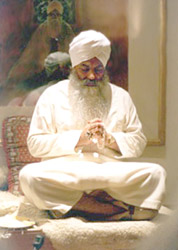 But the best and the safest way that can be tried by anyone easily is Mantra Sadhna. When Kundalini is activated there is a tremendous gush of energy which can cause great harm if not properly channelised through the body. But the Mantra Sadhana process is a slow and steady method totally free of such risk. Mantra Sadhna is carried out under the guidance of a Guru who has full control over the awakening of Kundalini.
But the best and the safest way that can be tried by anyone easily is Mantra Sadhna. When Kundalini is activated there is a tremendous gush of energy which can cause great harm if not properly channelised through the body. But the Mantra Sadhana process is a slow and steady method totally free of such risk. Mantra Sadhna is carried out under the guidance of a Guru who has full control over the awakening of Kundalini.
Whatever the mode of activation a Guru is a must for during the process as the divine powers in the body come to life they attack the Sadhak`s weaknesses like greed, jealousy, infatuation, anger, false ego and other negative traits. Sometimes the struggle between these positive (Kundalini) and negative energies can be so intense that a person may lose balance of mind or his evil traits may appear so magnified to him that he may take to wrong ways in life. These are the reasons for which make a Guru an essential part of Kundalini teachings, who will also suggest Guru Mantra Sadhana. The power of Guru is so strong that it can annihilate all evil traits of the Sadhak.
There are different Mantra`s for the activation of the six Chakras. One should always remember that it is not a miracle that one is working on, but is a slow and steady process and sometimes it is only after some months that, one may suddenly become aware of the awakening of the concerned Chakra. One should hence continue with Sadhana of other Chakras even if no immediate results seem forthcoming. Sometimes two or three Chakras have been seen to be activated all of a sudden at one go.
The first step for Kundalini activation is taking Guru Diksha and later praying to the Guru for Kundalini Jagran Diksha ( Diksha for activation of the Kundalini). After this the Guru suggests certain Mantra Sadhanas through which the Kundalini can be fully activated.
It depends on person-to-person how soon Kundalini can be activated. For some it may take six months to activate and for some it may take even more. It is not a rule that one can try the Sadhana of the next Chakra only after the first one has been activated. One can complete all the Sadhanas one after the other without waiting for results.
Preparation for Kundalini activation:
Fundamental practices for activation of Kundalini shakti:
1. The aspirant should purify his or her body with the aid of Neti, Dhyoti and Vasti.
2. After that, the aspirant should practice eight kinds of Pranayam (Yogic exercises).
3. After that the aspirant should learn from his Guru the essential mudras such as Mahamudra, Mahavedha, Mahabandh, Viparitakarani, Taran, Paridhan, Yuktichalan and Shaktichalani.
4. The aspirant, having perfected all Yogic exercises should concentrate his psyche on `Chakra` according to the method of `Raja Yoga`.
Some regular exercises are as follows, which if one does regularly derives in the early success of activation.
1. Get up at five in the morning
2. Practice both kinds of Bhrastika Pranayam (fast breathing) five to twenty five times
3. Practice both kinds of Shaktichalini Mudra five to ten times
4. Practice Taran Mudra with four to hundred & one Pranayam
5. Practice Praridhan Yukti Chalan Mudra
6. At last perform mental exercises of activating `Chakra`
In case one is not able to devote time in the morning, one should do the following:
1. Mahamudra - Five to twenty five times on each leg
2. Mahabandha - Five to twenty five times on each leg
3. Mahavedh - Both kinds of Mahavedh five to ten times
4. Viparitkarani Mudra - Five to ten times
5. The rest part of the time should be utilised for practice of activating `Chakra`
At the initial stages an aspirant might experience increased perspiration from his or her skin but gradually this perspiration will diminish and there will be a lightening sensation in ones entire body, after which there is likely to be the movement of `Pran Shakti` (life force) in the manner of crawling of an ant. This will be the upliftment of Kundalini Shakti and the activation of the Muladhar Chakra.



